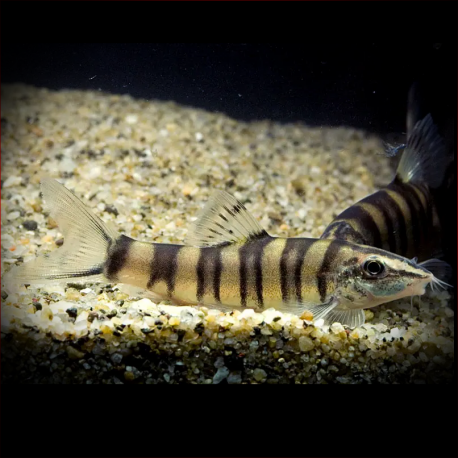More info
Datasheet
| Minimum Tank Size | 120 litres / 31.70 US gallons |
| Maximum Size | 10.0cm / 3.94inches |
| Temperature | 20°C / 68.00°F - 25.5°C / 77.90°F |
| Hardness | 2.02dgH / 36ppm - 15.02dgH / 268ppm |
| pH | 6.5-8.0 |
General Description
The Sinibotia Robusta, also known as the Kansu Loach, is commonly traded under vernacular names such as 'golden Chinese loach' and '12-banded Chinese loach.' With a relatively deeper and stockier body compared to other members of its genus, this species boasts around 6 dark, vertical body bars that usually bifurcate as the fish matures. Belonging to the family Botiidae within the order Cypriniformes, the Kansu Loach is likely a benthic predator that feeds on insects, crustaceans, and smaller fishes in its natural habitat.
Aquarium Setup
The Kansu Loach thrives in a well-structured tank containing sand or fine gravel, smooth rocks, driftwood, and branches. Lighting can be subdued, and compatible plants like Microsorum and Anubias can be added for aesthetic and shading purposes. Providing ample cover is crucial, as these inquisitive fish enjoy exploring their environment. To prevent injury, sharp-edged items should be avoided, and gaps sealed with aquarium-grade silicone sealant to prevent trapping. Regular water changes and spotless water conditions are essential for their well-being.
Behaviour
Generally reclusive, the Kansu Loach prefers quieter areas of the aquarium and tends to seek cover when not feeding. They exhibit peaceful behavior and can coexist safely with various fish species that share similar environmental requirements. In larger tanks, suitable tankmates include members of Barilius, Luciosoma, Balantiocheilos, and Botia. Maintaining a small group of 3-4 individuals is recommended to prevent potential aggression or stress within the species.
Feeding and Diet
In captivity, the Kansu Loach isn't finicky and can be fed a varied diet consisting of live or frozen bloodworm, Tubifex, chopped shellfish, earthworms, and high-quality sinking dried foods. Once acclimated, their feeding behavior becomes vigorous, often ascending into the midwater to feed. Providing a diverse and nutrient-rich diet is crucial for their overall health and longevity.
Reproduction & Dimorphism
Reproduction of the Kansu Loach remains unrecorded in aquarium settings, but in their natural habitat, they likely follow a seasonal spawning pattern. Sexual dimorphism is unconfirmed, but mature females are expected to have a more robust body structure compared to males.
Habitat and Distribution
Native to southern China, particularly in the Li Kiang region near Nanning city in the Guangxi Autonomous Region, the Kansu Loach inhabits moderate-to-slow flowing streams or river channels with clear water and sandy-rocky substrates. Their distribution extends to various tributaries of the Zhu Jiang system, including the Liu Jiang and Gui Jiang rivers. Despite the industrialization of their habitat, these loaches can still be found in the polluted lower reaches of the river systems.

